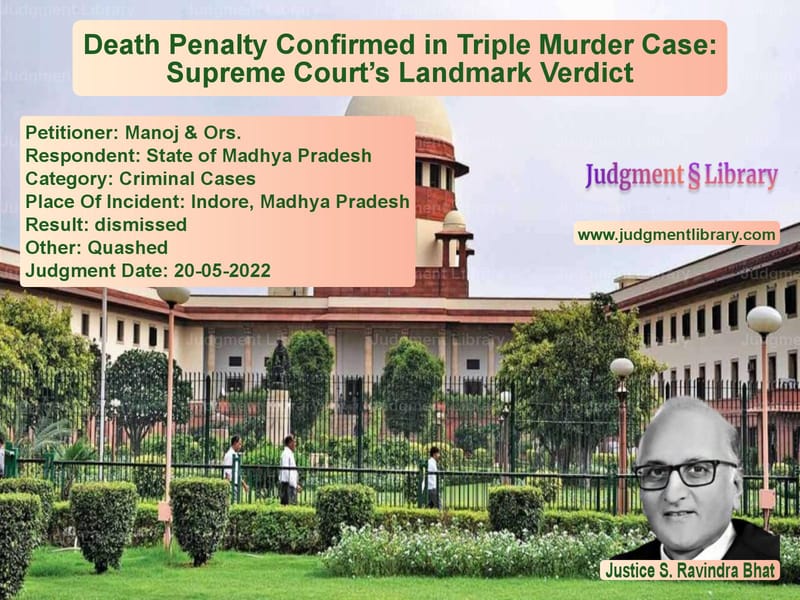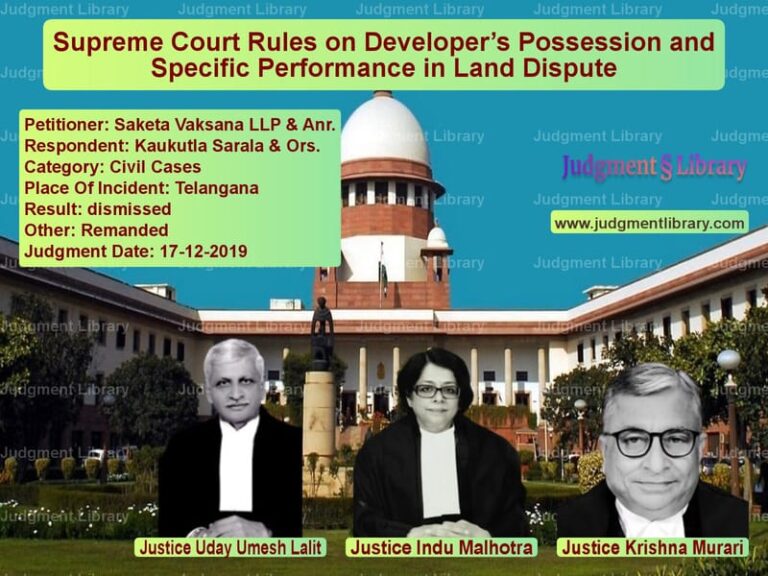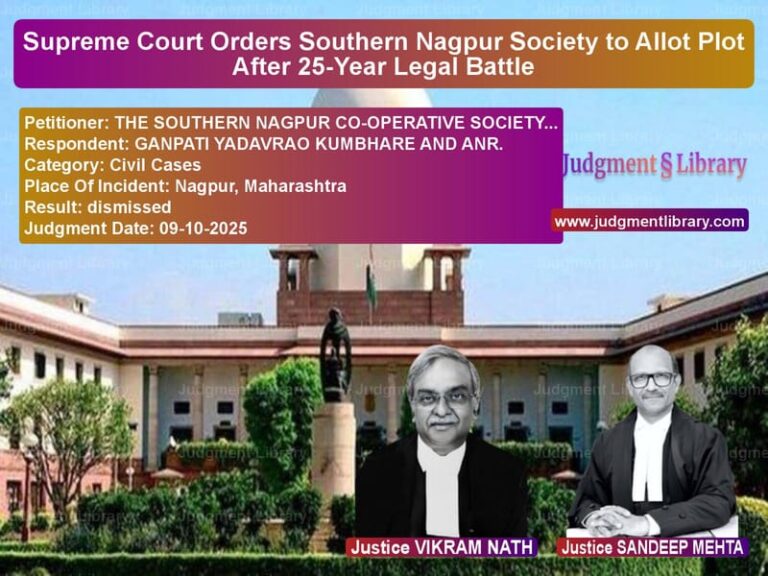Death Penalty Confirmed in Triple Murder Case: Supreme Court’s Landmark Verdict
The Supreme Court of India recently delivered a significant judgment in the case of Manoj & Ors. v. State of Madhya Pradesh, affirming the death penalty for three individuals convicted of a gruesome triple murder during a robbery. The case involved a thorough examination of forensic evidence, circumstantial proof, and legal principles governing capital punishment.
The three appellants—Manoj, Rahul @ Govind, and Neha Verma—were convicted under Section 302 of the Indian Penal Code (IPC) for the murder of three women, Megha Deshpande, Ashlesha Deshpande, and Smt. Rohini Phadke, on June 19, 2011. The trial court imposed the death penalty, and the High Court of Madhya Pradesh upheld the sentence. The Supreme Court’s decision was based on a meticulous review of evidence, including DNA analysis, fingerprint verification, and ballistic reports.
Background of the Case
The crime took place in Indore, Madhya Pradesh, when the victims were found murdered in their home. The assailants had entered the house under the pretense of knowing the victims, before attacking them with knives and a firearm. The crime scene revealed multiple stab wounds on the victims, a gunshot injury on one, and clear signs of a struggle.
PW-1, the complainant and husband of the deceased Megha, discovered the murders after being alerted by a neighbor. He immediately informed the police, leading to the registration of an FIR at MIG Colony Police Station. The police began an investigation and recovered several crucial pieces of evidence, which later became key factors in the prosecution’s case.
Arguments Presented in Court
Prosecution’s Case
- The prosecution argued that the murders were committed during a robbery planned by the accused.
- Stolen jewelry belonging to the victims was recovered from the accused.
- DNA evidence linked the accused to the crime scene.
- Fingerprints of the accused were found at the crime scene.
- Ballistic evidence confirmed that the gunshot wound found on one of the victims was from the firearm recovered from the accused.
Defense’s Arguments
- The defense contended that the accused had been falsely implicated.
- The police investigation was flawed, with procedural lapses in the collection and preservation of evidence.
- The prosecution’s reliance on circumstantial evidence was insufficient to prove guilt beyond a reasonable doubt.
- The delay in conducting forensic tests and fingerprint analysis raised doubts about the authenticity of the evidence.
Key Evidence and Legal Analysis
Fingerprint Evidence
- Investigators lifted fingerprints from the crime scene, including the doors, furniture, and objects near the victims.
- PW-24, a forensic expert, testified that the fingerprints of the accused matched those found at the crime scene.
- The court ruled that the fingerprint evidence conclusively placed the accused inside the house at the time of the murders.
DNA Analysis
- Bloodstains found on the clothes of the accused matched the DNA profiles of the victims.
- PW-35, a DNA expert, presented a report confirming the match.
- The defense questioned the integrity of the DNA samples due to delays in testing, but the court ruled that the evidence remained reliable.
Ballistic and Forensic Reports
- A bullet recovered from one of the victims was confirmed to have been fired from the weapon seized from one of the accused.
- PW-16, the ballistic expert, testified that test-firing results matched the bullet found at the crime scene.
- Rahul was found with a gunshot wound on his foot, which matched the trajectory of a bullet recovered from the crime scene.
Judicial Principles on Capital Punishment
- The Supreme Court analyzed whether this case fell under the “rarest of the rare” category, justifying the death penalty.
- The court cited previous judgments establishing guidelines for awarding capital punishment.
- The brutality of the crime, the targeting of defenseless victims, and the lack of remorse by the accused weighed heavily in favor of the death sentence.
Final Judgment
The Supreme Court upheld the death penalty for all three accused, stating that the crime was brutal, premeditated, and warranted the harshest punishment under the law. The court ruled that:
- The evidence conclusively established the guilt of the accused beyond a reasonable doubt.
- The circumstances left no room for doubt about their direct involvement in the murders.
- The crime was committed with extreme cruelty, and the accused showed no possibility of reform.
The verdict reinforces the judiciary’s stance on ensuring justice for victims of violent crimes and serves as a precedent for future cases involving similar heinous offenses.
Petitioner Name: Manoj & Ors..Respondent Name: State of Madhya Pradesh.Judgment By: Justice S. Ravindra Bhat.Place Of Incident: Indore, Madhya Pradesh.Judgment Date: 20-05-2022.
Don’t miss out on the full details! Download the complete judgment in PDF format below and gain valuable insights instantly!
Download Judgment: manoj-&-ors.-vs-state-of-madhya-prad-supreme-court-of-india-judgment-dated-20-05-2022.pdf
Directly Download Judgment: Directly download this Judgment
See all petitions in Murder Cases
See all petitions in Bail and Anticipatory Bail
See all petitions in Fraud and Forgery
See all petitions in Juvenile Justice
See all petitions in Custodial Deaths and Police Misconduct
See all petitions in Judgment by S Ravindra Bhat
See all petitions in dismissed
See all petitions in Quashed
See all petitions in supreme court of India judgments May 2022
See all petitions in 2022 judgments
See all posts in Criminal Cases Category
See all allowed petitions in Criminal Cases Category
See all Dismissed petitions in Criminal Cases Category
See all partially allowed petitions in Criminal Cases Category







